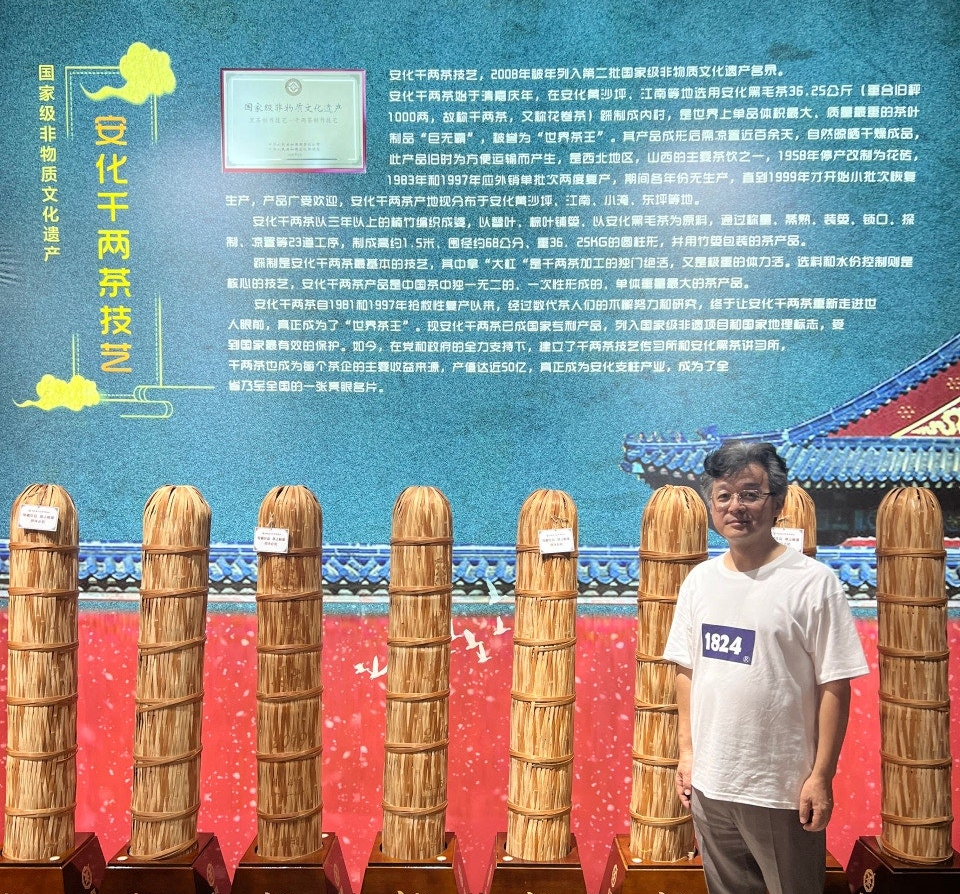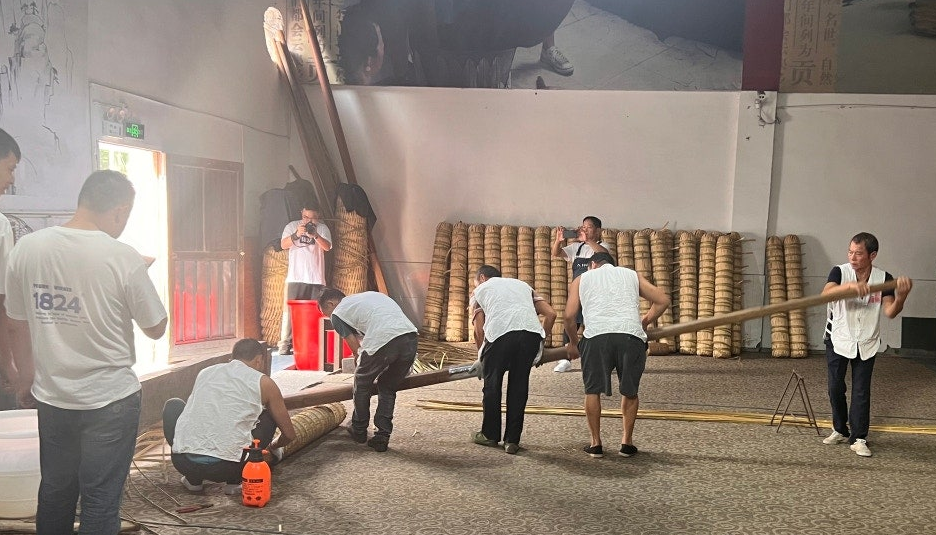
천량차(千兩茶)는 중국 호남성 안화현(安化縣) 강남 일대에서 생산되는 대표적인 흑차입니다. 그 기원에 대해서는 두 가지 설이 전해집니다. 하나는 청나라 도광(道光) 초년, 진상(晋商)과 안화의 황사평(黃仕平)이라는 차인이 수년에 걸쳐 시험을 반복한 끝에 만들어냈다는 것이고, 또 다른 하나는 안화 자하(紫河) 강변의 유 씨(劉氏) 가문이 개발하였으며, 그 기술이 대대로 전해졌다는 이야기입니다. 비록 설은 다르지만, 중화인민공화국 수립 전까지 천량차의 생산기술은 오로지 유 씨 가문 직계에게만 전수되었습니다.
역사 기록에 따르면 중국에서 흑차는 국경 무역에서 후발주자로 등장했습니다. 변방의 차 생산은 사천성에서 시작되어 호남성으로 이어졌죠. 호남성 흑차는 주로 안화에서 생산되며, 이 지역의 차 유통은 복자완(卜子垸)에서 모초구(茅草口, 차오커우)로 이어졌고, 차오커우는 곧 안화 남쪽 최대의 차시장으로 발전했습니다. 안화 흑차는 명나라 초기에 사천 흑차(乌茶)의 가공법을 응용해 개선된 것으로, 명나라 만력 22년(1594년)에는 조정의 관차(官茶)로 지정되며 위상을 갖추게 됩니다. 사천 흑차와는 다른 독자적인 제조법으로 만들어진 안화 흑차는 독특한 모양과 검고 윤기 나는 색깔, 부드러운 향과 뛰어난 품질, 그리고 저렴한 가격으로 인해 북서쪽 차 상인들에게 큰 인기를 끌었습니다. 안화 흑차는 점차 사천 흑차를 대체하며 북서쪽의 주요 차로 자리 잡았습니다.

천량차는 청나라 도광 연간(1821-1850)에 호남성 안화현 강남 지역에서 탄생했습니다. 도광 원년(1821년) 이전에는 산서성 상인들이 안화에서 흑차를 구입하여 노새와 말을 이용해 산서로 운반했는데, 부피를 줄이고 운송 효율을 높이기 위해 차를 밟아 압축한 형태로 만들었습니다. 당시 이런 종류의 흑차는 '리허차(澧河茶)'라고 불렸습니다. 이후 산서성 차 상인들은 포장 방식을 개선하여 100냥짜리 흑차를 원통형으로 포장했는데, 이를 ‘백량차’라고 불렀습니다.
청나라 동치 연간(1862-1874)에는 진상 ‘삼화공’이라는 차 상인이 백량차를 기준으로 차의 무게를 1,000냥으로 늘려 대나무 바구니에 담아 원통형으로 포장했습니다. 이것이 바로 ‘천량차’입니다. 이후 안화 고가계(高家溪)와 마가계(马家溪)의 고품질 흑모차를 원료로 사용하여 더욱 엄격하게 품질을 관리하고, 독특한 원통형 모양과 3겹의 포장 방식으로 품질과 위생, 아름다움을 모두 갖춘 차를 만들었습니다. 또한, 차를 다지는 기술과 힘을 더욱 강화하여 더욱 단단하게 만들었습니다. 이때 길이는 5척(1,665m), 둘레는 1.7척(0.56m)이며, 외부 포장에 3겹으로 포장합니다.
천량차는 크게 ‘기주권(祁州卷)’과 ‘장저우권(绛州卷)’ 두 종류로 나뉩니다. 기주권은 산서 기현과 위치 지역의 차 상인들이 주로 취급하며, 하나의 무게가 1,000냥이고 생산량이 많습니다. 강주권은 강주 차 상인들이 취급하며, 하나의 무게가 1,100냥이고 생산량이 적습니다. 각 권의 길이는 약 5척(1.665m), 둘레는 약 1.8척(0.60m)입니다.
‘천량차’라는 이름은 바로 무게, 즉 1,000냥(약 31.25kg)에서 유래합니다. 외부 포장은 대나무로 짠 화격 바구니로 감싸며, 표면에는 아름다운 무늬가 드러납니다. 원통형 외관은 마치 두루마리처럼 보여 ‘화권차(花卷茶)’라고도 불립니다.

천량차는 소비자들에게 ‘중국 고대 실크로드의 신비로운 차’로 불릴 만큼 특별한 가공 기술을 자랑합니다. 천량차의 모든 공정은 수작업으로 진행되며, 복잡한 기술과 높은 노동 강도, 숙련된 기술을 요구합니다. 천량차는 안화 고가계, 마가계 등 고품질 흑모차를 원료로 사용하여 체질, 선별, 성형, 악퇴 등 과정을 거치며, 찌고, 덮고, 펴고, 싸고, 엮는 등 23가지 복잡한 공정을 거쳐 완성됩니다. 가공 과정에서는 8명의 숙련된 남성이 힘을 합쳐 차를 다져야 하며, 일정한 박자와 힘으로 차를 단단하게 만듭니다. 이 과정에서 흥을 돋우고 힘을 내기 위해 민요와 같은 노래를 부르기도 합니다. 노동 강도가 매우 높고 섬세한 기술이 요구됩니다. 생산에는 8명의 숙련된 청장년이 나서야 하며, 일사불란한 동작으로 차를 밟고, 누르고, 꼬고, 말아야 좋은 품질의 천량차가 완성됩니다. 이 과정에서 고유의 리듬과 구호가 이어지며, 마치 민요처럼 가공장을 채웁니다.
“짐을 들어라! 좀 더 무겁게… 천천히 굴려라! 막대기가 잘 눌려, 발판이 안정되어 움직인다! 작은 막대기가 고르게 꼬여져 있고, 향차는 서쪽 입구에서 팔리네… 좋은 차는 만병을 치료하네…”
천량차는 섬세하고 복잡한 과정을 거쳐 만들어지기 때문에 매우 단단하고 밀도가 높습니다. 한 차 상인은 천량차를 7년 동안 물에 담갔지만 속이 젖지 않았다는 이야기가 전해질 정도입니다.
천량차는 가공 후 건조대에서 여름과 가을의 햇볕, 이슬, 바람을 맞으며 약 30-50일 동안 건조됩니다. 이 과정을 통해 천량차는 자연의 기운을 흡수하고 장기간 숙성 과정을 거칩니다. 숙성 과정에서 차의 효소 작용과 미생물 대사 작용으로 인체에 유익한 물질이 생성되며, 숙성 기간이 길수록 차의 품질이 향상됩니다. 또한, 차는 폴리곤 잎, 갈색 조각, 대나무 껍질의 향 성분과 햇빛의 정수를 흡수하여 독특한 색, 향, 맛을 갖게 됩니다. 이러한 특징으로 인해 천량차는 소비자들에게 큰 사랑을 받으며, 음용 가치와 소장 가치가 높습니다. 천량차는 1년에 4-5개월 동안만 생산되며, 생산량이 매우 적고 숙성 기간이 길어 더욱 귀하게 여겨집니다.
https://youtu.be/hGQOL78h690?si=ON6yQUH9AdMJJQHA
Qianliang Tea: A Legacy of Tradition and Craftsmanship
Qianliang Tea (千兩茶) is a representative dark tea produced in the Jiangnan region of Anhua County, Hunan Province, China. Its origin is traced back to two prevailing theories. One suggests that during the early years of the Daoguang era (1821–1850) of the Qing Dynasty, Jin merchants and a tea artisan named Huang Shiping from Anhua developed the tea after years of experimentation. The other story attributes its creation to the Liu family, who lived along the Zihe River in Anhua and passed down the technique through generations. Although the origin stories differ, it is widely accepted that until the establishment of the People’s Republic of China, the production techniques for Qianliang Tea were kept exclusively within the Liu family lineage.
According to historical records, dark tea emerged later in China's border trade markets. Production began in Sichuan Province and eventually expanded into Hunan. In Hunan, dark tea was primarily produced in Anhua. The region’s tea trade developed from Boziyuan to Maocaokou, which became the largest tea market in southern Anhua. Anhua dark tea originated in the early Ming Dynasty and was refined by referencing the processing methods of Sichuan’s dark tea (Wucha). In the 22nd year of the Wanli Emperor’s reign (1594), Anhua dark tea was designated as an official tribute tea, elevating its status. Its unique production method, distinct from that of Sichuan tea, produced teas with plump shapes, glossy black color, a mellow aroma, excellent quality, and reasonable prices—making it highly popular with tea merchants in the northwest. Eventually, Anhua dark tea overtook Sichuan’s dark tea in that market.
Qianliang Tea was born during the Daoguang era (1821–1850) in the Jiangnan region of Anhua County. Before 1821, merchants from Shanxi Province would purchase bulk dark tea from Anhua and compress it into tighter forms to reduce volume and ease transport via mules and horses. This form of tea was initially called “Lihe Tea” (澧河茶). Later, Shanxi tea merchants improved the packaging method, compressing 100 liang (taels) of dark tea into cylindrical shapes known as “Bailiang Tea.”
During the Tongzhi period (1862–1874), a tea merchant named “Sanhuagong” expanded upon this format, increasing the weight to 1,000 liang (approximately 37.25kg by old measurement standards) and packaging the tea in large cylindrical bamboo baskets. This gave rise to Qianliang Tea. Over time, high-quality heicha (dark loose tea) from Gaojiaxi and Majiaxi in Anhua was selected for its production, with stricter quality control, refined cylindrical shaping, and triple-layered wrapping for better hygiene and visual appeal. The finished tea logs were 5 chi (approximately 1.665 meters) long and 1.7 chi (about 0.56 meters) in circumference.
Qianliang Tea is broadly categorized into two types: Qizhoujuan (祁州卷) and Jiangzhoujuan (绛州卷). Qizhou-type teas, handled mainly by merchants in Qi County and Yuci of Shanxi, weigh about 1,000 liang each and are produced in large quantities. Jiangzhou-type teas, managed by merchants from Jiangzhou, weigh around 1,100 liang each and are produced in smaller quantities. Each roll typically measures around 5 chi in length and approximately 1.8 chi (0.60m) in circumference.
The name “Qianliang Tea” derives from its weight—1,000 liang, equivalent to about 37.25 kilograms using ancient Chinese scales. It is wrapped in a bamboo-woven basket, with decorative patterns forming naturally on the surface. The cylindrical shape, resembling a scroll, also earned it the nickname Hua Juan Cha (花卷茶), meaning “flower roll tea.”
Qianliang Tea is often referred to as the “mystical tea of the ancient Silk Road,” thanks to its intricate and time-honored production methods. Every stage is carried out manually, requiring high physical endurance and exceptional skill. The tea is crafted from premium dark loose teas from Gaojiaxi and Majiaxi, going through a series of processes—sorting, shaping, drying, steaming, pressing, and weaving—totaling 23 detailed steps.
Its production involves eight robust and skilled men working in synchronized movements to compress and shape the tea. To maintain rhythm and morale during this labor-intensive process, the workers chant traditional work songs, infusing the tea-making with a cultural and spiritual rhythm.
“Lift the load! A little heavier now… Roll it slowly! The stick presses firm, and the footboard holds steady! The small stick is twisted evenly; the fragrant tea sells well at the western gate… Good tea heals all ailments…”
Because of its densely compressed structure, Qianliang Tea is extraordinarily durable. It is said that one merchant once soaked a tea roll in water for seven years, and the inside remained dry—a testament to its remarkable compactness.
After shaping, the tea is placed on racks and left to dry under natural sunlight, moonlight, and breeze for 30 to 50 days during summer and autumn—without being exposed to rain. This “breathing in the essence of nature” initiates a long-term aging process. During this time, natural enzymes, microbial activity, and environmental interactions transform the tea’s internal components into beneficial substances. The longer the aging, the richer and more aromatic the tea becomes. Additionally, the tea absorbs the scents of the polygonum leaves, palm bark slices, and bamboo wrappings, as well as the solar essence, creating its unique color, aroma, and taste.
Due to its exceptional flavor, health benefits, and rarity, Qianliang Tea is highly prized both for consumption and collection. It is produced only 4 to 5 months out of the year, in very limited quantities. Moreover, it requires an aging period of 7 to 8 years before it can be released to the market—adding to its value and mystique.
'흑차 이야기' 카테고리의 다른 글
| 흑차의 매력: 복전차, 흑전차, 화전차의 차이점(The Allure of Hei Cha) (39) | 2025.04.19 |
|---|---|
| 천량차, 그 신비로운 매력과 정성스러운 제작 과정(The Enigmatic Charm and Meticulous Craftsmanship of (34) | 2025.04.16 |
| 흑차를 마시면 좋은 점(Benefits of drinking Dark tea) (25) | 2025.04.09 |
| 6대 차의 특징 (25) | 2025.04.05 |
| 한국차의 역사 (24) | 2025.04.02 |



